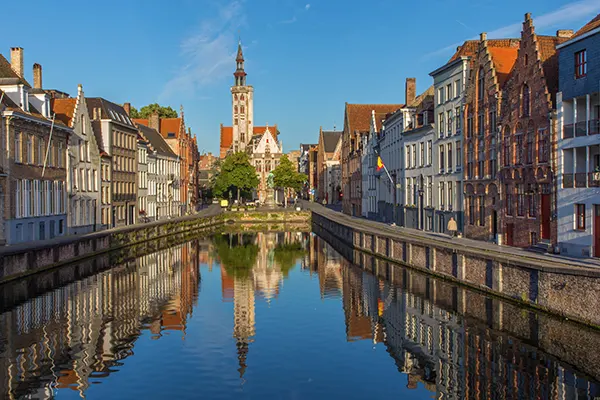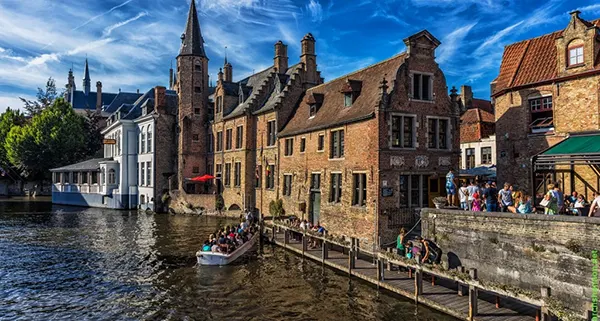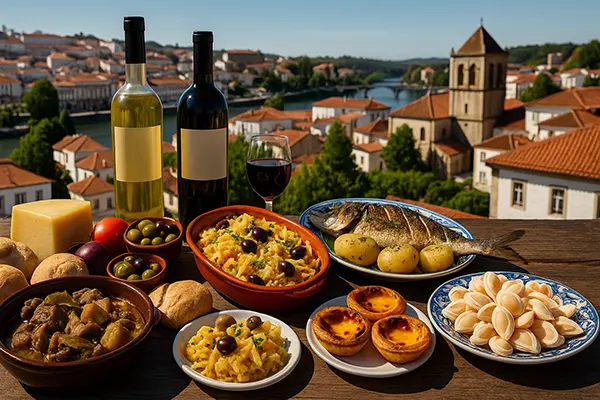
Bruges, Belgium — A Mediaeval Fairytale with Canals and Chocolate
Bruges, often called the Venice of the North, is one of the most picturesque cities in Europe. With its cobbled streets, peaceful canals and rich history, it has become a magnet for travellers seeking authentic experiences. Today, Bruges is not only a UNESCO World Heritage Site but also a living reminder of Europe’s mediaeval heritage, blending tradition with modern culture.
The Historic Heart of Bruges
The city centre of Bruges has preserved its mediaeval charm almost entirely intact. Visitors can explore the Grote Markt, where the Belfry Tower rises high above colourful guild houses. This square has been the economic and political hub of Bruges for centuries, offering a glimpse into its prosperous past as a trading powerhouse in Northern Europe.
Another key attraction is the Burg Square, home to the Basilica of the Holy Blood. This small but remarkable church houses a revered relic said to contain a drop of Christ’s blood. Alongside it stands the Gothic-style Town Hall, one of the oldest in the Low Countries, which showcases the city’s historic role in governance and culture.
Walking through the old streets, one can feel the continuity of history. The atmosphere is enriched by architectural details, hidden courtyards and narrow alleys that reveal the city’s layered story, from its medieval rise to its modern-day preservation.
UNESCO Recognition and Preservation
In 2000, Bruges was inscribed on the UNESCO World Heritage List due to its well-preserved urban fabric and historical significance. The recognition ensures ongoing preservation of its architectural heritage and cultural identity. This status also highlights the importance of sustainable tourism to protect its fragile balance between local life and global interest.
Bruges’ commitment to conservation extends beyond its buildings. The city has developed strict regulations to maintain its historic skyline, limit modern development, and preserve the character of its canals. Such policies reflect the responsibility of keeping a living city authentic and vibrant while adapting to modern needs.
For visitors, this dedication translates into an unparalleled experience of stepping back in time without losing the comfort of today’s amenities. It is precisely this balance that makes Bruges stand out among European heritage cities.
Canals and Chocolate Culture
The canals of Bruges create a distinctive charm, winding through the city like silver ribbons. Once used for trade and defence, today they are one of the main attractions, best enjoyed by boat tours that provide a unique perspective of the city’s architecture. Every bend offers a postcard-perfect view that embodies the essence of Bruges.
Equally central to the city’s identity is its chocolate. Belgium has long been known as a leader in chocolate craftsmanship, and Bruges is home to some of the finest chocolatiers in the world. Shops like The Chocolate Line and Dumon have become iconic, offering hand-made pralines and innovative creations that attract connoisseurs from across the globe.
For those who want to dive deeper into this sweet tradition, the Choco-Story museum presents the history of cocoa, from its origins with the Mayans and Aztecs to the evolution of Belgian chocolate making. It is a place where culture and gastronomy blend seamlessly.
Beer and Culinary Delights
Bruges is equally famous for its brewing heritage. The city’s beers, such as those from the De Halve Maan brewery, reflect centuries of tradition. Visitors can tour the brewery to understand the craft behind these renowned Belgian beers and taste them fresh on site. Local brews often pair perfectly with regional dishes, elevating the gastronomic experience.
The culinary scene of Bruges also embraces Flemish classics. Dishes like Flemish stew with beer sauce, mussels with fries, and artisan cheeses reflect the local traditions. Michelin-starred restaurants sit side by side with cosy bistros, ensuring every traveller can find something to enjoy.
Together, chocolate and beer form an essential part of Bruges’ cultural fabric, giving visitors more than just sightseeing opportunities but also a taste of the region’s living heritage.

Modern Bruges and Tourism
Bruges thrives not only as a historic gem but also as a modern city that welcomes millions of visitors each year. With careful planning, it has managed to avoid the negative impacts of mass tourism while still remaining accessible and engaging for global audiences. Its pedestrian-friendly centre makes it easy to explore by foot or bicycle.
The city also invests in cultural events that keep traditions alive while adding contemporary creativity. Festivals such as the Procession of the Holy Blood, the Bruges Triennial of Contemporary Art, and various music and food events offer a dynamic mix of past and present. This diversity makes Bruges attractive to both history enthusiasts and modern culture lovers.
Another strength of Bruges is its accessibility. Located just one hour by train from Brussels, it is easy to reach for both international tourists and locals. Its proximity to the North Sea coast also makes it a convenient stop for those exploring Flanders more broadly.
Sustainable Future of Bruges
As of 2025, Bruges continues to balance its cultural heritage with sustainability goals. The city has invested in eco-friendly transport, energy efficiency measures, and waste management to reduce its environmental footprint. This ensures that tourism does not overwhelm its delicate ecosystem.
Local authorities work closely with residents to promote responsible tourism, encouraging visitors to respect the historic surroundings and contribute to the preservation of local life. This cooperative spirit helps maintain the authenticity of the city and its liveable quality for inhabitants.
Bruges is also exploring smart tourism strategies, using digital tools to manage visitor flow, provide real-time information, and enhance the visitor experience. These innovations demonstrate that even a city rooted in the Middle Ages can lead in sustainable and forward-thinking practices.





